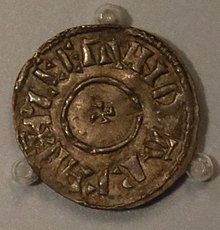Plegmund
Plegmund | |
|---|---|
| Archbishop of Canterbury | |
 Coin of Plegmund in the Ashmolean Museum, Oxford | |
| Appointed | 890 |
| Term ended | 2 August either 914 or 923 |
| Predecessor | Æthelred |
| Successor | Athelm |
| Orders | |
| Consecration | 890 |
| Personal details | |
| Died | 2 August either 914 or 923 |
| Sainthood | |
| Feast day | 2 August |
| Venerated in |
|
| Canonized | Pre-Congregation |
Plegmund (or Plegemund;
Early life
Little is known of the early life of Plegmund except that he was of
Archbishop of Canterbury
Plegmund was selected for the
During the 9th century, the see of Canterbury was at a low point. One of Plegmund's responsibilities was to re-establish its authority, and, in an attempt to do this, between 909 and 918 he created new sees within the existing
Under Plegmund's archbishopric, the quality of the Latin used by his scribes improved, surpassing the poor quality used by the scribes of the previous two archbishops, Ceolnoth and Æthelred.[3] When Alfred died in 899, Plegmund crowned his son Edward as king.[6]
In addition to his religious duties, Plegmund was involved in matters of state and he attended the formal councils held by Edward the Elder in 901, 903, 904 and 909. He dedicated the tall tower of the New Minster at Winchester in 909.[3]
Death and legacy
Plegmund died on 2 August 914
Notes
- ^ Plegmund is a rare name, and Plemstall means "holy place of Plegmund". The name of the island is recorded early in the 12th century; it is possible that the tradition is accurate.[4]
- ^ Manuscript F of the Anglo-Saxon Chronicle says "chosen" instead of elected.[8]
Citations
- Archdiocese of Thyateira and Great Britain. Retrieved 9 December 2019.
- ^ a b Farmer Oxford Dictionary of Saints pp. 438–439
- ^ a b c d e f g h i Wareham "Plegemund" Oxford Dictionary of National Biography
- ^ a b Brooks Early History of the Church of Canterbury pp. 153–154
- ^ a b Hindley Brief History of the Anglo-Saxons pp. 215–217
- ^ a b c Keynes "Plegmund" Blackwell Encyclopedia of Anglo-Saxon England
- ^ Stenton Anglo-Saxon England pp. 270–271
- ^ a b Swanton (trans.) Anglo-Saxon Chronicle pp. 82–83
- ^ Duckett Alfred the Great p. 113
- ^ Abels Alfred the Great p. 224
- ^ Stafford Unification and Conquest p. 182
- ^ Fryde, et al. Handbook of British Chronology p. 214
References
- Abels, Richard Philip (1998). Alfred the Great: War, Kingship, and Culture in Anglo-Saxon England. New York: Longman. ISBN 0-582-04047-7.
- ISBN 0-7185-0041-5.
- Duckett, Eleanor Shipley (1956). Alfred the Great: The King and his Kingdom. Chicago: ISBN 0-226-16779-8.
- Farmer, David Hugh (2004). Oxford Dictionary of Saints (Fifth ed.). Oxford, UK: Oxford University Press. ISBN 978-0-19-860949-0.
- Fryde, E. B.; Greenway, D. E.; Porter, S.; Roy, I. (1996). Handbook of British Chronology (Third revised ed.). Cambridge: Cambridge University Press. ISBN 0-521-56350-X.
- Hindley, Geoffrey (2006). A Brief History of the Anglo-Saxons: The Beginnings of the English Nation. New York: Carroll & Graf Publishers. ISBN 978-0-7867-1738-5.
- ISBN 978-0-631-22492-1.
- ISBN 0-7131-6532-4.
- ISBN 978-0-19-280139-5.
- ISBN 0-415-92129-5.
- required)
External links
